<<PREVIOUS -
HOME -
CONTENTS -
NEXT>>
OMSI ASTROIMAGING -
![]()
<<PREVIOUS -
HOME -
CONTENTS -
NEXT>>
OMSI ASTROIMAGING -
![]()
OMSI Astrophotography Workshop 2009 Summary
Oregon Museum of Science and Industry (OMSI) Classroom 1 1945 SE Water Avenue Portland, OR 97214-3354, USA Updated on March 15, 2009 |
| |
|
|
|
|
|
|
|
|
|
|
|
|
|
|
|
|
|
|
|
|
|
|
|
||
|
||
|
|
||
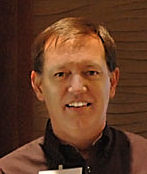
Kevin Nelson, Quantum Scientific Imaging, Inc. Kevin Nelson is co-founder of Quantum Scientific Imaging, a manufacturer of cooled CCD cameras designed by and for astrophotographers. Kevin is an avid sailor and history buff whose interest in stargazing began with studying the Age of Exploration and celestial navigation. Today, Kevin shares the joys and challenges of imaging the night sky from his backyard with his two young sons. |
||
|
|
||
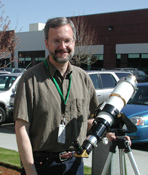
Dave Sandage has been an active imager and visual astronomer since childhood. His first astro images were piggyback shots using Tri-X film in the early 70's. He moved on to hypered tech pan film in the late 80's and started CCD imaging using an SBIG ST-5 in the 90's. Dave currently images using a variety of cameras including an SBIG ST-2000XM and an ST-4000XCM from his observatory in Forest Grove. Dave co-authored the user's manual for the Gemini Telescope Control System, and more recently wrote a series of articles on guided imaging in AstroPhoto Insight magazine. Dave has spoken on numerous topics at imaging conferences and star parties |
||
|
|
||
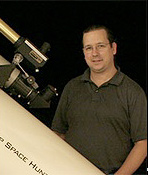
Neil Heacock is an IT professional who moved out of the city for the first time in 2003. After living in LA, Seattle and Portland, he moved to somewhat more rural area of Clark County and really saw the stars. This birthed a strong interest in astronomy which has continued to grow and develop over the past 6 years. In 2006 Neil began to dabble in astrophotography and after attending the 2007 Northwest Astrophotography Conference his imaging stared to mature. Neil primarily considers himself a visual observer but with such amazing and easy to use imaging systems available he now images with one setup while observing with another. Neil uses a Canon 20D DSLR camera and the images he produces are excellent. |
||
|
|
||
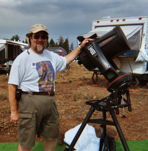
Steve Jaynes has had an interest in astronomy since first viewing the Moon, Saturn, and Jupiter in a 60mm department-store refractor the fall of 1961 soon after starting the 7th grade. He earned a 3" reflector by selling Christmas cards that same year. He maintained an active interest in all areas of science though out school, including astronomy as part of his Earth Sciences undergraduate program. As an adult he received a 4.5" reflector from his wife as a Christmas present, built his own 6Ē Newtonian, and later horse-traded an early Z-80 computer for a Celestron C-8. He continued both his observational astronomy and his first foray into astrophotography using the venerable C-8 coupled with a Nikon SLR body and an off-axis guider. In the mid 90ís, spurred by a move to California for a temporary work assignment, Steve parted with the C-8 intending to replace it with a more modern scope with electronics equipped mount and a larger aperture. Unfortunately that replacement was delayed until 2004 when he purchased his current Celestron GPS-11. Since then, heís been rebuilding his observing and astrophoto equipment kit, recently adding the Starizona Hyperstar kit to the scope and an eight mega-pixel QHY-8 single shot cooled CCD camera and has been active in both visual and photographic astronomy than ever before. His early efforts with the new kit have been very gratifying allowing him to capture images in a few nights that he wasnít able to capture in several years of film photography. Steve supports his astronomy hobby by working as the manager at IBM Corpís Network Transformation Laboratories, with over 40 years in the computer industry. He enjoys sojourns to remote locations, using his solar-power equipped travel-trailer as a home-away from home. Since 2004, heís viewed from western locations from Canada to Mexico, attending the All-Arizona Messier Marathons in 2006 & 2008. |
||
|
|
||
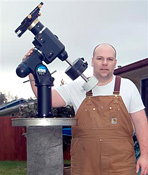
Walt Davis is an amateur astronomer who has a strong interest in astrophotography. Being a software engineer/architect and with modern advancement in computerized telescopes, Walt realized that unlike when he was a kid, today it was possible for the normal person to observe the night sky. What he could not have foreseen is the so called "e;Astrophotography Bug"e;. He now focuses mostly on wide field imagery using high end camera lenses like the Nikon 600mm f4 ED super telephoto lens. To see some of his imagines visit http://www.waltdavis.net/astronomy/ |
||
|
|
||
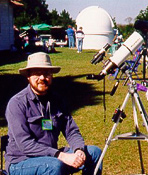
David Haworth enjoys astronomy imaging and processing those images to bring out details that cannot be seen easily by visual observing with the same size optics. David Haworth started astroimaging with a Cookbook CCD camera he built in 1996 and since then has used many types of cameras to image the sky. David wrote Chapter 2: "Afocal Photography with Digital Cameras" in the second edition of "The Art and Science of CCD Astronomy" which was published in December 2005. David's images have appeared in magazine front covers, articles, books, catalogs, videos, music CD covers, T-shirts, other web sites, etc. |
||